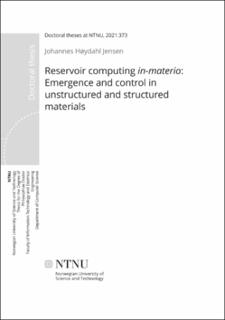| dc.contributor.advisor | Tufte, Gunnar | |
| dc.contributor.advisor | Langseth, Helge | |
| dc.contributor.advisor | Nichele, Stefano | |
| dc.contributor.author | Jensen, Johannes Høydahl | |
| dc.date.accessioned | 2021-12-08T07:05:07Z | |
| dc.date.available | 2021-12-08T07:05:07Z | |
| dc.date.issued | 2021 | |
| dc.identifier.isbn | 978-82-326-5163-4 | |
| dc.identifier.issn | 2703-8084 | |
| dc.identifier.uri | https://hdl.handle.net/11250/2833246 | |
| dc.description.abstract | This thesis is an exploration of novel material substrates for computation. Guided by the principles of material computation, we investigate what computations a material supports naturally. The goal is to perform computation close to physics, exploiting physical properties directly for more efficient computing devices. At the same time, we seek to understand the emergent computational mechanisms that are present within a material. We stress the importance of suitable computational models for understanding and exploiting novel physical systems. The model used in this work, reservoir computing, provides a powerful lens in which the computational properties of a material can be analyzed. Three material substrates with distinct qualities are explored in this work. First, we investigate the computational properties of carbon nanotube nanocomposites. We find that these unstructured materials can exhibit complex dynamics in response to electrical stimuli, but that the limited control offered makes exploitation difficult. Next, we consider a simple chaotic circuit as a substrate for reservoir computing. We demonstrate how such a simple physical system can be exploited for computation. Its simplicity, controllability and structure enables detailed analysis, yielding insight into what physical properties are important for computation. Finally, we dive into the world of artificial spin ice (ASI): a family of structured magnetic metamaterials composed of coupled nanomagnets. ASI systems display a rich variety of complex emergent behavior, while at the same time offering considerable control. We explore the complex dynamics available in “square” ASI, and demonstrate how its computational properties can be controlled and exploited. A new ASI simulator was developed to support further investigations, which can capture realistic dynamics of large-scale ASI systems within practical time frames. We introduce reservoir computing in artificial spin ice, and quantify the reservoir quality of “pinwheel” ASI. A key result is that the emergent large-scale patterns of pinwheel ASI can be exploited at different scales of observation, ranging from individual magnets to the collective state of the resulting metamaterial. These findings, combined with highly developed fabrication techniques, make ASI very promising material substrates for future computing devices.
Our results highlight important properties of material computing systems, the degree of control offered by different materials, and what insight can be gained from reservoir computing in-materio. | en_US |
| dc.language.iso | eng | en_US |
| dc.publisher | NTNU | en_US |
| dc.relation.ispartofseries | Doctoral theses at NTNU;2021:373 | |
| dc.relation.haspart | Paper A. Stefano Nichele, Johannes Høydahl Jensen, Dragana Laketic, Odd Rune Lykkebø and Gunnar Tufte. Dynamics in Carbon Nanotubes for In-Materio Computation. International Journal on Advances in Systems and Measurements, 2016, 9 (1 & 2), pp 24-37. | en_US |
| dc.relation.haspart | Paper B. Johannes H. Jensen and Gunnar Tufte. Reservoir Computing with a Chaotic Circuit. The Fourteenth European Conference on Artificial Life, ECAL 2017, 14, pp 222-229. DOI 10.7551/ecal_a_039 | en_US |
| dc.relation.haspart | Paper C. Johannes H. Jensen, Erik Folven and Gunnar Tufte. Computation in artificial spin ice. The 2018 Conference on Artificial Life (ALIFE). 2018, pp. 15-22, isal_a_00011. DOI https://doi.org/10.1162/isal_a_00011 | en_US |
| dc.relation.haspart | Paper D. Johannes H. Jensen, Anders Strømberg, Odd Rune Lykkebø, Arthur Penty, Magnus Själander, Erik Folven and Gunnar Tufte. flatspin: A Large-Scale Artificial Spin Ice Simulator. 2020. In review: preprint in arXiv:2002.11401 | en_US |
| dc.relation.haspart | Paper E. Johannes H. Jensen and Gunnar Tufte. Reservoir Computing in Artificial Spin Ice. The 2020 Conference on Artificial Life (ALIFE). 2020, pp. 376-383, isal_a_00268. | en_US |
| dc.title | Reservoir computing in-materio: Emergence and control in unstructured and structured materials | en_US |
| dc.type | Doctoral thesis | en_US |
| dc.subject.nsi | VDP::Teknologi: 500::Informasjons- og kommunikasjonsteknologi: 550 | en_US |
